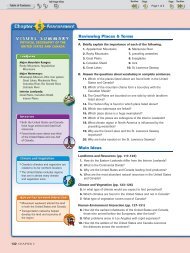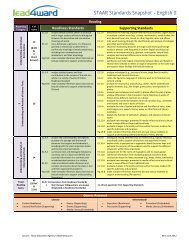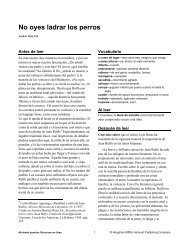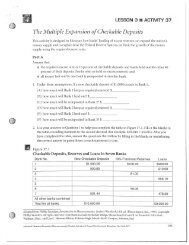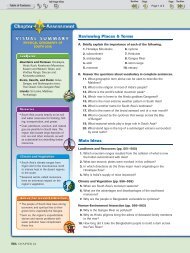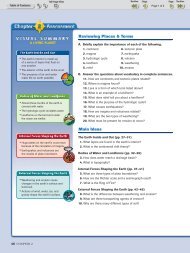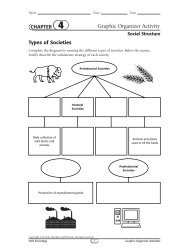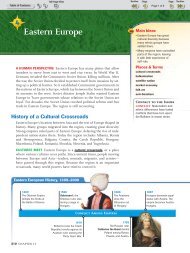File chapter 13 section 1 mediterranean europe.pdf - Teacher
File chapter 13 section 1 mediterranean europe.pdf - Teacher
File chapter 13 section 1 mediterranean europe.pdf - Teacher
Create successful ePaper yourself
Turn your PDF publications into a flip-book with our unique Google optimized e-Paper software.
289-293-Chapter<strong>13</strong> 10/16/02 10:53 AM Page 292<br />
architecture was like. Spain has Roman aqueducts, structures that carried<br />
water for long distances, and Muslim mosques, places of worship.<br />
The region also has a long artistic legacy, which includes classical statues,<br />
Renaissance painting and sculpture, and modern art produced by<br />
such artists as Pablo Picasso of Spain. The pictures on page 291 contrast<br />
Renaissance Italian art with Muslim Spanish art.<br />
Economic Activity*<br />
10%<br />
31%<br />
24%<br />
12%<br />
27%<br />
8%<br />
24%<br />
Greece<br />
1952 1995<br />
39%<br />
Italy<br />
1952 1995<br />
36%<br />
Trade<br />
35%<br />
25%<br />
29%<br />
Industry<br />
Portugal<br />
1952 1995<br />
51%<br />
52%<br />
47%<br />
Agriculture<br />
Other<br />
14%<br />
3%<br />
14%<br />
4%<br />
16%<br />
21%<br />
26%<br />
19%<br />
33%<br />
SOURCE: United Nations Statistical Yearbooks, 1955, 1997<br />
NOTES: Industry includes mining and construction;<br />
other includes government, utilities, transportation,<br />
and service industries.<br />
* as percentage of GDP<br />
SKILLBUILDER: Interpreting Graphs<br />
SEEING PATTERNS From 1952<br />
to 1995, which economic activities increased<br />
and which decreased?<br />
MAKING INFERENCES Why do you<br />
think the category “other” changed so<br />
significantly? Give possible reasons.<br />
Economic Change<br />
Because of the Mediterranean region’s sunny climate and historic sites,<br />
tourism has long been a large part of its economy. In other ways, the economy<br />
has been changing rapidly since World War II.<br />
AGRICULTURE TO INDUSTRY In general, the<br />
Mediterranean nations are less industrial than those<br />
of Northern and Western Europe. For centuries, the<br />
region’s economy was based on fishing and agriculture.<br />
Fishing remains important, and olives, grapes,<br />
citrus, and wheat are still major agricultural crops.<br />
But in the late 20th century, the region’s economy<br />
grew and changed. Today, manufacturing is increasing.<br />
The making of textiles is Portugal’s biggest<br />
industry. Spain is a leading maker of automobiles,<br />
and Italy is a major producer of clothing and shoes.<br />
Service industries, such as banking, also make up a<br />
much larger part of the economy than before.<br />
In the 1980s, Greece, Portugal, and Spain joined<br />
the European Union (EU). This aided growth by promoting<br />
trade with other EU nations and by making<br />
financial aid from the EU available.<br />
ECONOMIC PROBLEMS The region still faces economic<br />
challenges. For example, Italy’s northern<br />
region is much more developed than its southern<br />
half. The reasons for this include the following:<br />
• The north is closer to other industrial countries of<br />
Europe, such as Germany and France.<br />
• The south has poorer transportation systems.<br />
• The government tried to promote growth in the<br />
south but made bad choices. It started industries<br />
that did not benefit the local people.<br />
Another problem is that the entire Mediterranean<br />
region is poor in energy resources and relies heavily<br />
on imported petroleum. This makes the region vulnerable<br />
because trade problems or wars could halt oil<br />
supplies and prevent industries from functioning.<br />
Modern Mediterranean Life<br />
Mediterranean Europe saw political turmoil in the<br />
20th century. Two dictators, Benito Mussolini in Italy<br />
Background<br />
The EU is an<br />
economic and<br />
political alliance<br />
of 15 nations.<br />
Italy was one<br />
of the founding<br />
members.<br />
292 CHAPTER <strong>13</strong>





